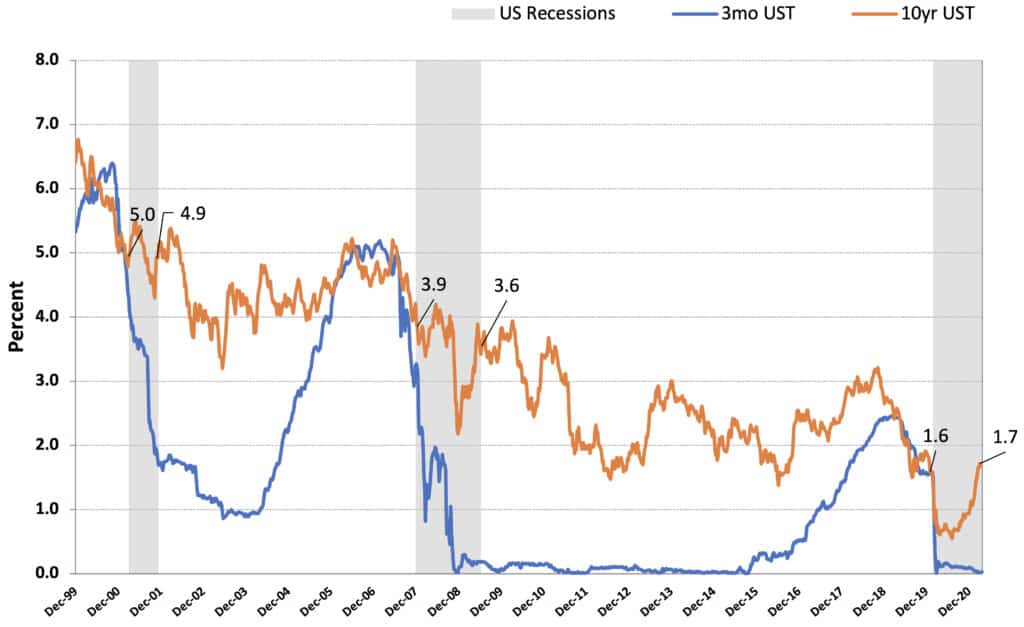As the US economy continues to work its way out of the recession brought on by the Covid-19 pandemic, many economists debate what the future will hold. With inflation, asset bubbles, rising rates, and the effect of fiscal spending being hot topics during board and ALCO discussions, the question becomes this: What should we do to prepare our balance sheet for what may come? However, for all these discussions about potential future challenges to earnings, seldom do boards and ALCOs discuss the earnings lost due to opportunity cost.
Opportunity cost lurks as a silent killer of margins, especially given the current abundance of liquidity in financial institutions. While tax returns and stimulus checks continue to add to the excess of liquidity, the earnings on those dollars remains at near zero. With all the uncertainty in the economy, many financial institutions fall victim to sitting on the sidelines waiting for a clearer picture to emerge and are missing out on the current opportunity the market is giving them.
3-Month UST vs. 10-Year UST

While the official start of the current recession was February 2020, the downturn in economic activity began much earlier with the Fed acting quickly to soften the blow and lower rates. The drop in short-term rates was quick and the 10yr treasury followed suit, dropping from 1.60% at the start of the recession to a low of 0.55% by August of 2020. Following that low the 10yr started moving higher and currently sits around 1.60% at the time of this writing, a level that is significant given the behavior of past recessions.
Upon the beginning of recovery following the previous two recessions, the 10yr regained its pre-recession levels and saw very little gains from that point, while short-term rates continued to either decline or remain lower for a prolonged period. The early 2000s recession, known for the dot-com bubble, saw the 10yr at 5.00% and eight months later hit 4.90% at the official end of the recession. During the Great Recession, which lasted more than twice as long, the 10yr entered the recession at 3.90% and hit around 3.60% at the beginning of the next recovery.
In both those cases the 10yr saw most of its gains in that initial jump to start the recovery, with very little if any increase beyond that. While the current recession is still considered to be ongoing, the 10yr has already reached its pre-recession levels. With the Federal Reserve pledging to continue keeping rates low, the opportunity for financial institutions to recoup lost margins is now.
The best way we can tackle both the pressures of future economic uncertainty as well as opportunity costs is to actively manage the risks to our balance sheet through sound asset liability management. While many will claim they already do this, the fact remains that a large number of financial institutions only manage parts of their balance sheet, leaving others on autopilot. The best performing institutions take advantage of all the tools available to them to ensure that these risks are properly managed regardless of what the economy and interest rates are doing.
Stabilizing Funding
One of the biggest fears that examiners have put into financial institutions is the idea that without warning we may be faced with a large run-off in our deposit portfolios. All too often this fear causes many institutions to overcompensate by holding on to more liquidity than is necessary. Looking at current call report data as deposits soar to record levels once again, many institutions find themselves questioning whether this liquidity is here to stay or is on the way out as quick as it came.
Maintaining excess levels of cash to have sufficient liquidity is not only inadequate risk management, it is also the most expensive method from an opportunity cost standpoint. Proper liquidity management means having sufficient cashflows as well as contingent liquidity sources to meet any loan demand or deposit withdrawals.
The better performing institutions tend to make use of the opportunities in wholesale funding from a source such as the Federal Home Loan Bank. With borrowing rates remaining low, the opportunity exists to make a positive spread on loans. So rather than wait for loan demand to make use of our excess cash, we can deploy those funds now to avoid lost income due to opportunity cost. In the worst case, if we are short on funds when loan demand comes in, we can borrow and still maintain positive margins.
Managing and Diversifying Loans
In a similar way to deposits, loans often fall victim to an autopilot style of management where loan demand ebbs and flows based both on volume and the types of loans, with seemingly little we can do about it. In reality, the loan portfolio can be diversified and managed similar to the investment portfolio through the use of loan participations. Selling loans can help us to manage excess flows in a particular loan type, alleviating concentration risk while also generating some off-balance sheet revenue through servicing income.
Purchasing loan participations can help fill the gaps in the loan portfolio where retail demand falls short, allowing us to diversify the loan portfolio and potentially hedge against prepayment or geographic risks. The relevant example being the large amount of refinancing recently seen in the mortgage market, which caused institutions that were mortgage heavy to experience faster than expected turn-over in their loan portfolios, resulting in a loss of income.
Investment Portfolio Management
Perhaps the biggest victim of opportunity cost is the investment portfolio, especially during times of rising rates and the effect of falling market values. Oftentimes boards and ALCOs will put these unrealized losses on investments under a microscope and will pause on purchasing more investments while they seek to understand what has happened. In reality, we tend to ignore the fact that the drop in valuation also affects our loans, a big part of interest rate risk, but more importantly that this is generally a good thing for the balance sheet as a whole.
Lower market values on our investments mean there is an opportunity for maturing investments to move into higher rates, allowing our portfolio income to grow and cash to be invested at a higher spread. The current investments will continue to generate income for us and, unless we choose to sell them prior to maturity, that loss will eventually disappear as the investment matures.
No one can predict exactly where the economy will go from here and waiting to get a clear direction will only cause us to fall victim to opportunity cost. The only way to properly address these uncertainties is to have strong asset liability management and to take advantage of all the tools available to help cultivate a balance sheet that is well diversified and actively managed across deposits, loans, and investments. In this way we ensure that we manage our institutions to the risks we know as opposed to the unknowns.
The Baker Group is one of the nation’s largest independently owned securities firms specializing in investment portfolio management for community financial institutions.
Since 1979, we’ve helped our clients improve decision-making, manage interest rate risk, and maximize investment portfolio performance. Our proven approach of total resource integration utilizes software and products developed by Baker’s Software Solutions* combined with the firm’s investment experience and advice.

Author
Greg Tomaszewicz
Managing Director
The Baker Group LP
800.937.2257
*The Baker Group LP is the sole authorized distributor for the products and services developed and provided by The Baker Group Software Solutions, Inc.
INTENDED FOR USE BY INSTITUTIONAL INVESTORS ONLY. Any data provided herein is for informational purposes only and is intended solely for the private use of the reader. Although information contained herein is believed to be from reliable sources, The Baker Group LP does not guarantee its completeness or accuracy. Opinions constitute our judgment and are subject to change without notice. The instruments and strategies discussed here may fluctuate in price or value and may not be suitable for all investors; any doubt should be discussed with a Baker representative. Past performance is not indicative of future results. Changes in rates may have an adverse effect on the value of investments. This material is not intended as an offer or solicitation for the purchase or sale of any financial instruments.